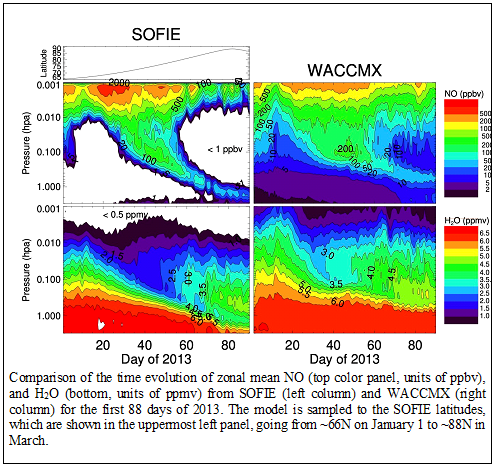|
STATUS:
08.17.2021
Instrument Status:
The spacecraft continues to perform nominally.
SOFIE
SOFIE is currently collecting sunset science observations, and housekeeping parameters all indicate a stable and healthy instrument. SOFIE V1.3 data are available online.
The Specified Dynamics version of the Whole Atmosphere Community Climate Model Extended (SD-WACCMX) was recently used to describe the descent of nitric oxide (NO) and other mesospheric tracers in the extended, elevated stratopause phase of the 2013 Sudden Stratospheric Warming (SSW) [Siskind et al., 2021]. The dynamics were specified with a high altitude version of the Navy Global Environmental model (NAVGEM-HA). Consistent with our earlier published results, we find that using a high altitude meteorological analysis to nudge WACCMX allows for a realistic simulation of the descent of lower thermospheric nitric oxide down to the lower mesosphere (See Figure below). This is important because the simulations only included auroral electrons, and did not consider additional sources of NO from higher energy particles, e.g. medium energy electron precipitation (>30 keV). This suggests that the energetic particle precipitation indirect effect (EPP-IE) can be accurately simulated without the need for additional NO production, provided the meteorology is accurately constrained. Despite the general success of WACCMX in simulating mesospheric NO, a detailed comparison of the WACCMX fields with the analyzed NAVGEM-HA H2O and satellite NO and H2O measurements from SOFIE and ACE-FTS reveals significant differences in the latitudinal and longitudinal distributions near 45-55 km altitudes. This stems from the tendency for WACCMX descent to maximize at sub-polar latitudes. These differences are linked to differences in the Transformed Eulerian Mean (TEM) circulation between NAVGEM-HA and WACCMX, most likely arising from small differences in how gravity wave forcing is represented. To compensate for differences in the modeled and observed NO, and quantify the amount of upper atmospheric NO delivered to the stratopause region, we used potential vorticity and equivalent latitude coordinates. Preliminary results suggest both model and observations are generally consistent with NO totals in the range of 0.1-0.25 gigamoles (GM).
Siskind, D. E., Harvey, V. L., Sassi, F., McCormack, J. P., Randall, C. E., Hervig, M. E., and Bailey, S. M.: 2 and 3-dimensional structure of the descent of mesospheric trace constituents after the 2013 SSW elevated stratopause event, Atmos. Chem. Phys. Discuss., https://doi.org/10.5194/acp-2021-68, 2021. (article).

|
|
|
